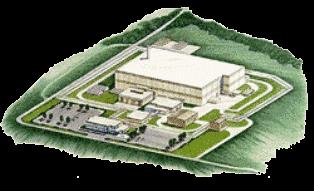 The US Department of Energy's National Nuclear Security Administration (NNSA) is overseeing the effort. It announced last week that the construction of the mixed-oxide nuclear fuel (MOX) facility at Savannah River was going on at a "brisk pace" with construction "25% complete".
The US Department of Energy's National Nuclear Security Administration (NNSA) is overseeing the effort. It announced last week that the construction of the mixed-oxide nuclear fuel (MOX) facility at Savannah River was going on at a "brisk pace" with construction "25% complete"."The design is 90% complete and preconstruction activity was completed under budget and ahead of schedule," according to the NNSA. The construction work is being carried out by contractors Shaw Areva MOX Services.
By 2016 the plant should begin combining plutonium oxide taken from weapons stockpiles with uranium oxide to make MOX fuel suitable for power generation in mainstream reactors. The fuel will then be used to generate electricity at Duke Energy's McGuire and Catawba nuclear power plants in North and South Carolina.
In addition, NNSA said it has been decided that the Savannah River plant will also use the plutonium to make 'starter fuel for advanced fast reactors'.
Similar cuts to plutonium stockpiles are also going on in Russia, but authorities there have planned to use the recovered plutonium in BN-600 and BN-800 fast breeder reactors at Beloyarsk from around 2012. The two nations agreed in 2000 to each dispose of 34 tonnes of 'surplus' plutonium. The USA recently added another 9 tonnes to that. NNSA said the total was enough plutonium for 17,000 nuclear weapons.
NNSA's work with plutonium stockpiles is part of an overall initiative to streamline American nuclear forces. While announcing a draft plan for the continuation of that work, NNSA director Tom D'Agostino said the US nuclear weapons stockpile will be reduced by nearly 50% from the 2001 level, making it the smallest stockpile since the 1950s.
President Bush's 2012 targets for reduction in the numbers of weapons have been achieved five years early, in 2007. And NNSA now thinks it will dismantle 15% more than the target by 2012.
Detecting materials trafficking
Under NNSA's Secure Freight Initiative, the US body has provided Singapore with with radiation detection equipment to scan US-bound cargo and help prevent illicit trafficking of nuclear and radiological material. Similar operations on a pilot scale are also going on at Hong Kong, and at ports in South Korea and Oman.
NNSA has also recently upgraded monitors and provided training at Limassol in Cyprus to detect smuggling of nuclear materials. That work was carried out under NNSA's Second Line of Defense program.
Further information
National Nuclear Security Administration (NNSA)
Savannah River Site
WNA's Military Warheads as a Source of Nuclear Fuel information paper
WNN: US nuclear wepons dismantling speeds up
WNN: More US warheads to be used for power generation
WNN: NNSA MOX facility construction starts




_47120.jpg)
_23621.jpg)

_63865.jpg)





